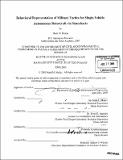| dc.contributor.advisor | Mark L. Homer and Brent D. Appleby. | en_US |
| dc.contributor.author | Hickie, Mark M | en_US |
| dc.contributor.other | Massachusetts Institute of Technology. Dept. of Civil and Environmental Engineering. | en_US |
| dc.date.accessioned | 2009-08-26T16:48:49Z | |
| dc.date.available | 2009-08-26T16:48:49Z | |
| dc.date.copyright | 2005 | en_US |
| dc.date.issued | 2005 | en_US |
| dc.identifier.uri | http://hdl.handle.net/1721.1/46550 | |
| dc.description | Thesis (S.M.)--Massachusetts Institute of Technology, Dept. of Civil and Environmental Engineering, 2005. | en_US |
| dc.description | Includes bibliographical references (p. 113-115). | en_US |
| dc.description.abstract | Over the past several years, aerospace companies have developed unmanned helicopters suitable for integration into military operations as reconnaissance platforms. These rotorcraft, however, require ground-based human controllers varying in number based on the size and complexity of the system controlled. The automation these platforms have achieved is limited to takeoffs, landings and navigation of pre-programmed waypoints. The possibilities for further development then are vast; with growing sensor and communication capabilities, there exists potential for unmanned rotorcraft to execute the full range of aviation missions normally reserved for manned assets. However, before military planners use autonomous helicopters as robust force multipliers, research must attempt to quantify possible tactics for software architecture implementation. This paper presents a methodology for developing autonomous helicopter tactics through the review of current military doctrine, pilot interviews, and simulation testing. Several tactics suitable for unmanned helicopters are recommended with an attempt to quantify the described behaviors using statecharts. The tactics diagrammed in the statecharts, or visual models that outline transitions between states based on conditions being met or events having occurred, are tested for feasibility in scenarios constructed with a US Army simulation tool, One SemiAutomated Forces (OneSAF) Testbed Baseline 2.0 (OTB 2.0). The ensuing results point to the success of using a thorough methodology to develop autonomous tactics and using statecharts to transfer qualitative behaviors into quantifiable actions. | en_US |
| dc.description.statementofresponsibility | by Mark M. Hickie. | en_US |
| dc.format.extent | 115 p. | en_US |
| dc.language.iso | eng | en_US |
| dc.publisher | Massachusetts Institute of Technology | en_US |
| dc.rights | M.I.T. theses are protected by
copyright. They may be viewed from this source for any purpose, but
reproduction or distribution in any format is prohibited without written
permission. See provided URL for inquiries about permission. | en_US |
| dc.rights.uri | http://dspace.mit.edu/handle/1721.1/7582 | en_US |
| dc.subject | Civil and Environmental Engineering. | en_US |
| dc.title | Behavioral representation of military tactics for single-vehicle autonomous rotorcraft via statecharts | en_US |
| dc.type | Thesis | en_US |
| dc.description.degree | S.M. | en_US |
| dc.contributor.department | Massachusetts Institute of Technology. Department of Civil and Environmental Engineering | |
| dc.identifier.oclc | 419344209 | en_US |
